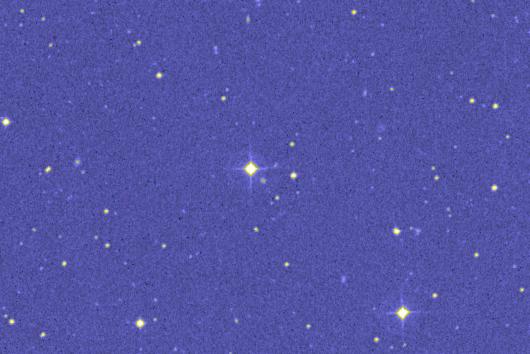
|
Credit & Copyright: Digitized Sky Survey
Explanation:
Centered in this unremarkable, 1/4 degree wide
patch of sky in
the constellation Aquarius
is the star Gliese 876.
Gliese 876
is smaller than the Sun, only about 1/3 as massive,
and too faint to be seen without a telescope.
But it is known to be one of the
nearest stars, only 15 light-years distant.
Astronomers have just announced
findings that imply Gliese 876
has a planet at least 1.6 times as massive as Jupiter - making
this now one of the
closest suspected planetary systems.
Like many recent discoveries, this
planet's detection is not based on
direct imaging
but on spectroscopic measurements
of the periodic change in motion or
"Doppler wobble" produced in the
parent star as the planet orbits.
The Doppler wobble
of Gliese 876 indicates that its planet orbits
once every 61 days at an average distance of about 1/5 the
radius of the Earth's orbit.
|
January February March April May June July August September October November December |
| ||||||||||||||||||||||||||||||||||||||||||||||||
NASA Web Site Statements, Warnings, and Disclaimers
NASA Official: Jay Norris. Specific rights apply.
A service of: LHEA at NASA / GSFC
& Michigan Tech. U.
Based on Astronomy Picture
Of the Day
Publications with keywords: extrasolar planet - Gliese 876
Publications with words: extrasolar planet - Gliese 876
See also:
- APOD: 2025 September 8 Á IRAS 04302: Butterfly Disk Planet Formation
- APOD: 2024 July 8 Á Exoplanet Zoo: Other Stars
- Temperatures on Exoplanet WASP 43b
- Epsilon Tauri: Star with Planet
- APOD: 2023 October 17 Á PDS 70: Disk, Planets, and Moons
- APOD: 2023 September 20 Á Methane Discovered on Distant Exoplanet
- APOD: 2023 June 6 Á Star Eats Planet
